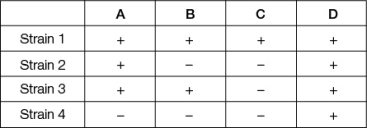Multiple Choice
Suppose that a certain wild-type bacteria can synthesize substance D, but various mutant strains cannot.We know that substance D is synthesized from substance X in a pathway that involves three intermediate substances (A, B, and C) , but we do not know the order of the steps in the pathway.The table shows four different mutant strains that have been tested for their ability to grow on the various substances.The "+" means that the strain can grow on that substance.The "‒" means that the strain cannot grow on that substance.  What is the most likely order of the pathway? (For example, A B C D indicates that substance A is converted to substance B, which is converted to substance C, which is converted to substance D.)
What is the most likely order of the pathway? (For example, A B C D indicates that substance A is converted to substance B, which is converted to substance C, which is converted to substance D.)
A) A B C D
B) A C B D
C) B A C D
D) C B A D
E) C A B D
Correct Answer:

Verified
Correct Answer:
Verified
Q214: The tRNA moves between three sites along
Q215: If the coding region of an mRNA
Q216: Draw a figure of a eukaryotic cell,
Q217: A mutation of a sigma factor in
Q218: If the DNA encoding a nuclear signal
Q220: The phenotype of an organism is primarily
Q221: Suppose the 5ʹ-to-3ʹ coding strand of DNA
Q222: The disease called branched-chain ketoaciduria is commonly
Q223: Errors in transcription occur about 100,000 times
Q224: Refer to the figure showing the process